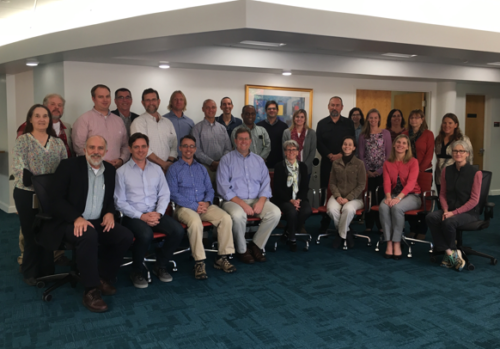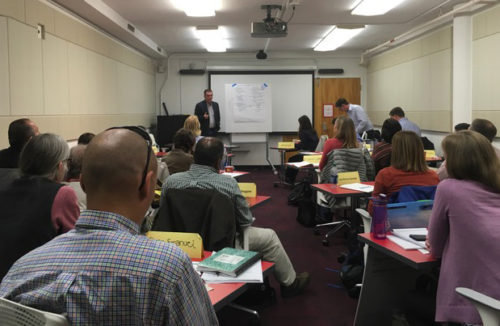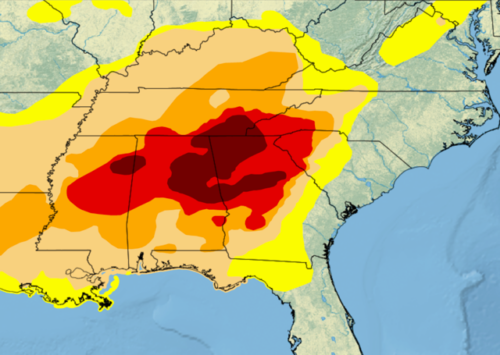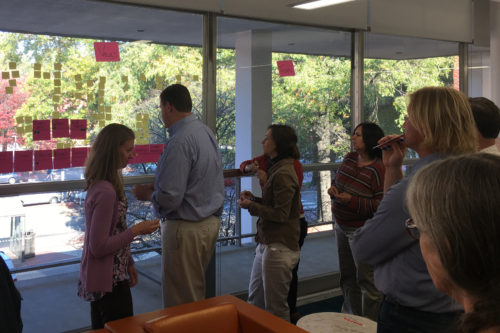Ecological drought in the Southeast U.S.: Forest fires, supermoon and new age libraries
Bill Dennison ·Simon Costanzo, Brianne Walsh and I traveled to Raleigh, North Carolina to meet with scientists associated with the USGS Southeast Climate Science Center to talk about ecological drought on 16-17 November 2016. Fittingly, there were forest fires raging in the Great Smoky Mountains as a result of a prolonged drought as we held the workshop. Forest fires are not common, particularly in November, in the Great Smoky Mountains, in spite of their name. The word "smoky" refers to the foggy appearance of the mountains that is caused by volatile organic compounds exuded by trees, and does not refer to smoke caused by fires. The concurrent drought and associated forest fires underscored the importance of our workshop.

We met in a conference room in the Hill Library of the North Carolina State University, organized by Cari Furiness, North Carolina State University. Jerry McMahon and Ryan Boyles, the Southeast Climate Science Center Director and Deputy Director, respectively, assembled a great group of scientists. We started with five excellent, succinct talks about climate (Ryan Boyles, US Geological Survey), eco-hydrology (Pete Caldwell, US Forest Service), wetlands (Kristen Lackstrom, Univ. South Carolina), freshwater ecosystems (Mary Freeman, USGS), and terrestrial ecosystems (Jen Cartwright, USGS). We learned that the Southeast region has abundant water resources but high and increasing water demands. The Southeast is a fast growing region, and water resources are going to become more crucial in the future, particularly with increased climate variability.


Simon conducted a 'Snap' exercise to elucidate and prioritize the key values and major threats in the Southeast US. We held breakout sessions to explore these values and threats more fully. For dinner, we walked in the light of a nearly full supermoon, so named because the moon was at its closest to the earth, to the Tupelo Honey Cafe, named for the Tupelo tree. The Tupelo tree is a native tree that grows in swampy land, appropriate for our ecodrought workshop topic. One of the joys of traveling around the U.S. as part of the initiative to visit each of the eight USGS Climate Science Centers.

On the second day of the workshop, we conducted a planning exercise to help formulate the research agenda for the Southeast Climate Science Center. We also introduced the " . . . and . . . but . . .therefore . . ." concept to structure narratives, and the workshop participants quickly adapted their research concepts into this format. We storyboarded the workshop newsletter before breaking up.
We were impressed with the Hill Library, but the workshop participants told us that we really should see the Hunt Library, also on the North Carolina State University campus. We made a visit to this library as well. It was an amazing building. Books were in a multistory set of book stacks, accessed by a computer driven robot that pulled large boxes from the shelves. Neither library had many visible books, but what they did have was an amazing array of working spaces, places to interact, and even places to snooze. Students were actively using both libraries, using white boards, writable table tops, multiple computer screens, small meeting rooms and comfortable chairs, couches and benches. This new library style is really an information center with interactive spaces. It seemed to me that everything in the libraries, including the high ceilings and furnishings, promoted creativity. I have always loved libraries, yet the libraries I am familiar with are largely book repositories. These North Carolina State University libraries are quite different from libraries full of books, but I am now a fan of this new style of library.

About the author
Bill Dennison

Dr. Bill Dennison is a Professor of Marine Science and Vice President for Science Application at the University of Maryland Center for Environmental Science.

